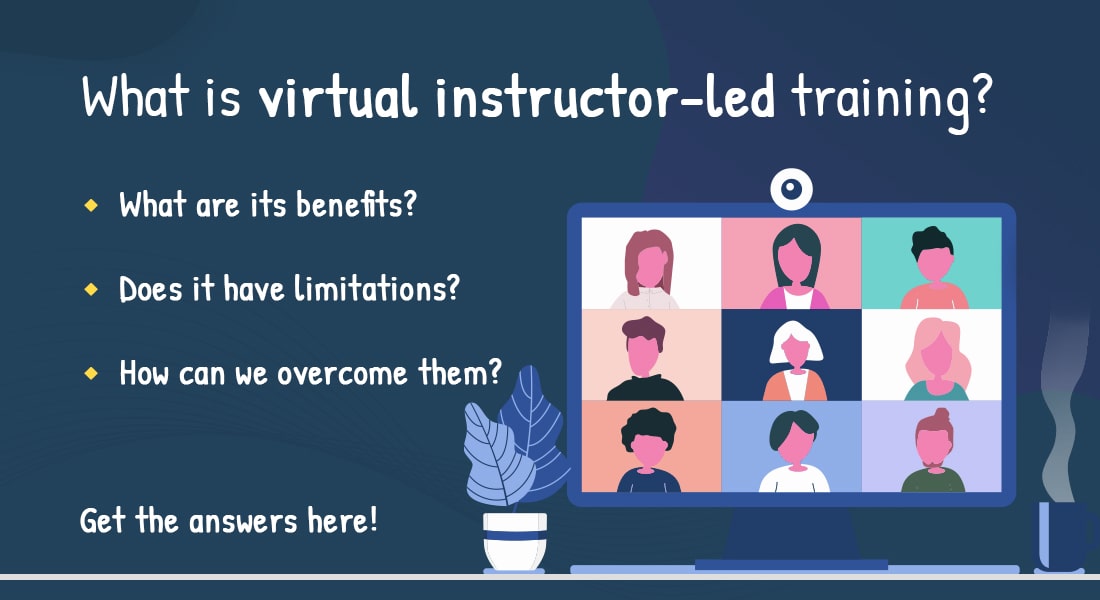5 Challenges of Virtual Instructor-led Training and How to Overcome Them

Virtual Instructor-led Training (VILT) is becoming an increasingly popular approach among L&D professionals, but heavy is the head that wears the crown. That’s right! The facilitators understand that it’s not always easy to conduct the training in a virtual setting. With multiple factors at play, each element has its own benefits and challenges. In the end, all elements combine to decide the success or failure of the session. In this blog post, we’ll look at five challenges that arise when delivering VILT and how you can overcome them by using some simple strategies.
Virtual Instructor-led Training Has Its Own Set of Challenges.
Here’s a list of 5 challenges often faced by VILT facilitators:
- Keeping the Learners Engaged
- Approaching and Delivering Content the Right Way
- Dealing with Wavering Attention
- Handling Technological Problems
- Managing Session Time
Worry not. We got the ways to overcome them! Read on to explore.
5 Challenges in VILT and their solutions
Challenge 1: Keeping the Learners Engaged
Engaging the audience, regardless of the mode of training, is an important component in deciding the effectiveness of the training session. It is based on various factors, such as interaction, content, interactivities, etc. All these elements together either make the session successful by imparting the desired information in a way that is retained by the trainees or a failure where they are checking the clock every minute for the session to be over because their brain is already asleep. Keeping this attribute in check becomes even more challenging as we shift from classroom training to virtual one.
Simply displaying the training content on the screen and speaking it out loud to the audience doesn’t do any good. Then what to do?
Solution:
To keep your audience attentive and engaged, provide them with a chance to participate. You can involve the learners in the course by catering to all the senses that promote learning and facilitate better understanding. For this, you can incorporate videos, audio, polls, scenario-based learning, storytelling, etc., in the lesson, which will motivate the trainees to pay attention and enable them to interact. You can also leverage chats to seek responses from the participants and breakout rooms to conduct group activities. All these components will contribute toward an overall engaging and interactive training session.
These components will help you break the monotony of the virtual training and promote active dialogue between the facilitator and participants, thereby attaining the desired learning outcome.
Here’s something informative and engaging for you to understand VILT inside out!
Challenge 2: Approaching and Delivering Content the Right Way
One size doesn’t fit all. And that’s another major challenge faced by the facilitators. We agree that the central idea and important themes of the training won’t change, but how you draft the content and the way you present it to the audience will vary significantly. The approach and aids that work well for classroom training are not equally effective for conducting a virtual training session. Classroom training enables face-to-face interaction, analyzing body language, and more personalized interaction, whereas virtual training, has a certain digital barrier that must be bridged by integrating other interactive multimedia. So, it’s crucial to plan and structure the training material in a virtually compatible format that fosters learning and not confusion. But how?
Solution:
Well, a virtual classroom allows you to include multiple interactivities and use different formats to make the learning more interesting than the traditional whiteboard-and-marker or reading-the-handout approach. The format of the training material must be aligned with the device features and online platform on which the training is delivered. It should be properly organized and easy to navigate, eliminating any possibility of confusion or uneasiness. This gives the facilitator more time to explain things rather than going back and forth between the content. The instructor can also include infographics, animations, etc., to explain important concepts.
Challenge 3: Dealing with Wavering Attention
With the rise of the digital age, attention spans have seen a significant low. People often struggle with paying attention and staying focused on one thing for a long time. Your audience is no exception, and the virtual setting escalates this problem even further. With no in-person interaction or control over the learning environment, it gets difficult for the trainer to make the learners pay attention to the information being provided. They can get easily distracted by something in their surroundings, or the element of disconnect can hamper the learning process. So how to deal with it?
Solution:
Dealing with reduced attention is difficult but not impossible. The instructor’s best bet to ensure their audience is attentive is to include engaging material, such as videos, infographics, flashcards, etc., that deviates from the regular information on the screen pattern. Keeping the session duration in accordance with the attention span of the learners is highly beneficial. Stretching the sessions for long hours reduces the effectiveness and leads to distraction and boredom.
Another method to involve the learners is by asking questions, conducting polls, seeking responses on chat, etc. Referring to the audience by their names allows for better interaction and alertness. Incorporating the “teach-back” method can be a beneficial practice to deal with a short attention span. It is a method where you ask the learners to explain the learned concept to the whole group.
Challenge 4: Handling Technological Problems
When it comes to conducting Virtual Instructor-led Training, not everybody is tech-savvy. This poses a great challenge for the facilitators. It requires certain skills and a basic understanding of the gadget and online platforms, which can give the trainers a tough time, thereby impacting the quality and effectiveness of the training provided. Online training entails scheduling a meeting, sharing the link, admitting the learners, managing the interaction, and much more. This surely can be nerve-wracking! Further proceeding with the interaction components, such as chat, question responses, and dividing teams for breakout rooms, can be cumbersome. Wondering what to do? Read on.
Solution:
Not everyone gets handy with technology in the first go. To handle this challenge like a pro, it’s advisable to arrange for a technical expert. They can help you deal with technical requirements or glitches without impacting training efficiency. You can even appoint a moderator to help you during the session for various purposes likes launching the polls, managing the breakout rooms, etc.
If you want to manage things independently, you can practice various processes like admitting the participants, sharing the screen, etc., beforehand. This will help you get familiar with the training platform design and obtain a fair idea about how it functions, thereby boosting your confidence and ability to conduct a successful corporate training session. You can also watch online videos or tutorials to gain a holistic understanding of the tech-related aspects involved in your media of interaction and ace them.
Challenge 5: Managing Session Time
When it comes to Virtual Instructor-led Training, timing is just as important as it is in any other type of corporate training. Delaying the session by five minutes, extending it by just ten minutes, omitting topics because you ran out of time, or rushing throughout the training to make up for the lost time are likely scenarios when you conduct an online training session but aren’t able to manage the time well. Also, suppose the session duration is not planned properly in terms of goals. In that case, it can lead to a loss of interest and attentiveness, thereby defying the whole learning objective of the corporate training.
Solution:
To take the bull by the horns, plan the duration of the training session by taking the learning objectives into account. Understand and accept the difference between classroom training and virtual training lessons and avoid lengthy sessions that stretch for hours. Rather, break them into shorter modules keeping in view the average attention span of visual learners. Spreading the sessions over days also allows time for learners to revisit the concepts and clarify doubts (if any) during the next session. Giving your audience a breather, or short breaks, breaks the cycle of monotony, helping them revive attention and start afresh.
Signing Off!
As a facilitator, it’s important to keep up with the latest trends in learning and training. Virtual Instructor-Led Training offers a unique opportunity in terms of accessibility, flexibility, and cost-effectiveness. However, no corporate training methodology is free from challenges. Overcoming the hurdles facilitates effective training and can help you make the best out of each training session. If you’re willing to go the extra mile to ensure successful virtual training, motivation and excitement are the elements you can’t miss. Check out this eBook to learn more about generating motivation and excitement in a virtual classroom.



![VILT Challenges: Crack Them Like A Pro! [Infographic]](https://blog.commlabindia.com/hubfs/Imported_Blog_Media/vilt-challenges-solutions-corporate-training.png)

